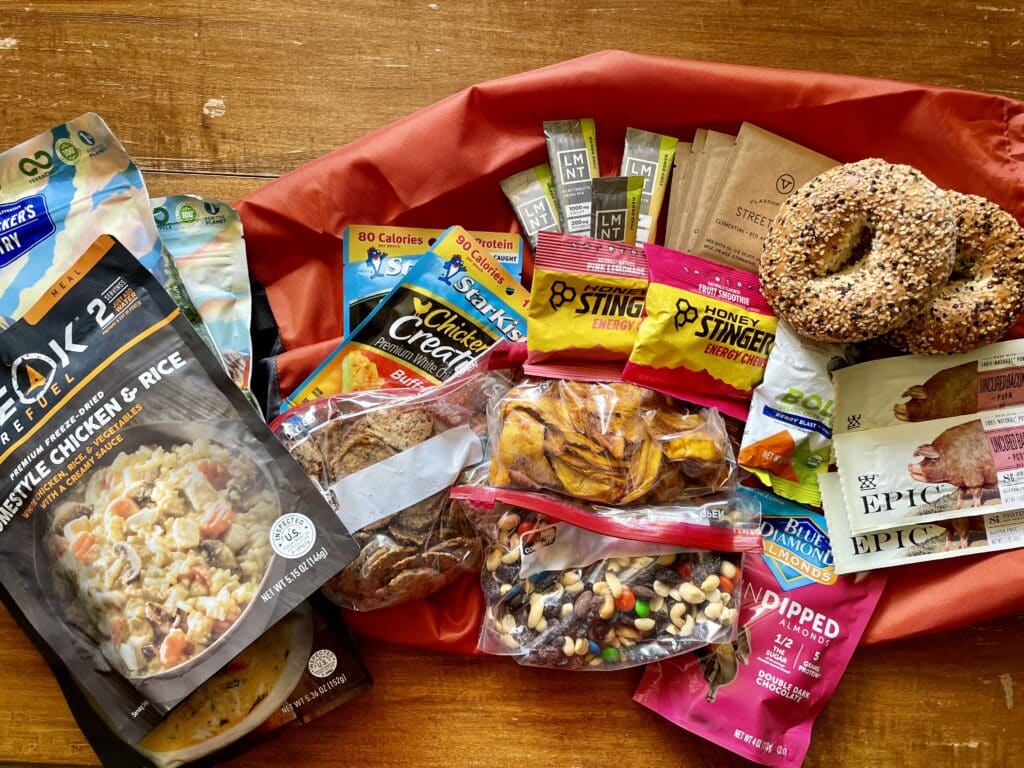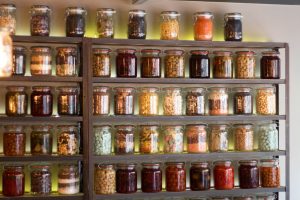I’m currently packing for my fourth multi-day backpacking trip in Wyoming’s Wind River Range. I’ve written before about how to use Plan to Eat for camping and backpacking, but I wanted to provide a detailed look at my food for a four-day trip into the wilderness.
Packing the right amount of food for a backpacking trip is a delicate balance. If you pack too much, you’re hauling around unnecessary weight that can make the trip less enjoyable from the back-breaking load of your pack. However, if you don’t pack enough food, you’ll be hungry and lethargic and if you end up in an emergency, you want to have enough food to be able to ration for an extra day or two.
I try to only eat one freeze-dried meal per day when I’m backpacking. Nowadays freeze-dried meals can be delicious, but they’re very filling (not great for a long day of hiking) and after days of eating mostly freeze-dried food, I get some gastrointestinal issues. This is why most of my ideas for breakfast and lunch are not freeze-dried meals, they are all still processed food, but will offer variety for your fuel sources. You can bring pre-made sandwiches or fruit (apples, oranges, kiwi), but I would recommend eating them on the first day or two of the trip to avoid them getting squished in your pack.
Backpacking Food Ideas
Breakfast:
Most of the time, I don’t like a heavy breakfast before a full day of hiking, but I do like to get some fuel in my body to start the day. I personally don’t like oatmeal because it’s not very satiating, but most people I hike with eat it in the morning. I stick to higher protein in the morning like the meat bars linked below.
- Granola and powdered milk
- Oatmeal packets – store-bought or homemade (instant oats, dried fruit, and powdered milk make a great breakfast)
- Peanut or almond butter pouches
- Epic Uncured Bacon and Pork bars
- Instant coffee (I like Verve for instant coffee that actually tastes good!)
- Dried fruit and beef jerky
- Powdered scrambled eggs
- Poptarts
Lunch:
- Tuna or chicken packets
- Bagels, cinnamon raisin bread, or tortillas
- Salami and Swiss cheese
- Hummus and crackers – there are lots of powdered hummus options out there!
- Instant rice or couscous – bring a favorite spice or sauce packet to add some flavor!
- Beef jerky and crackers
Dinner:
- Freeze-dried meals – my favorite brand is Peak Refuel, but there are so many out there to choose from, including vegetarian and vegan options.
- Powdered soup or ramen noodles
- Fresh caught mountain trout! If you like to fish, bring a travel-sized bottle of olive oil and fry fish in your Jetboil.
- Instant mashed potatoes and stove-top stuffing
Snacks:
- Trail mix
- Meat sticks – these Lil’ Landjaeger sticks are my favorite!
- Dried fruit – I like dried mango or apricots
- Meat jerky
- Crackers
- Candy or chocolate – dark chocolate will not melt as quickly if you’re hiking in warm weather.
- Energy chews, like Stingers
- Granola or protein bars
- Fruit leather
Sample 4-day Backpacking Meal Plan
I’m not overly concerned about hitting a certain number of calories each day, but you could calculate your estimated caloric needs and plan your meals around that. I try to stay adequately fueled, so I have energy, but I don’t want to feel full or get stomach cramps from eating too much while I hike.
Since this trip is only 4-days, I’m not too worried about having variety. If it was a multi-week trip, I would be looking for ways to switch up meals!
The first day is where I’ll pack something less processed or homemade, like an apple and breakfast burrito at the trailhead because I don’t have to worry about it getting squished in my pack. And for the first night, we often bring some fried chicken from the deli counter for dinner. It keeps well for a single day in the pack!
Other than that, every day will pretty much look the same:
Breakfast:
- Granola + powdered milk + Vital Farms Collagen powder for extra protein
- Instant coffee
- Bacon meat bar
Lunch:
- Salami and Swiss
- Whole grain crackers or half a bagel
- Dried mango
Dinner:
- Freeze-dried meal – I eat a whole package myself, even if it’s 2 servings.
Snacks (eaten throughout the day):
- Trail mix
- Meat snack sticks
- Jolly ranchers
- Stingers
- Poptarts

How to Pack Your Food
I use gallon ziplock bags to separate my food, either by meal or by day. I prefer to separate by meal, but I have separated by day before and it also works well. If you’re concerned about the number of calories or macros you’re consuming each day, you may prefer to separate your food by days.
For a 4-day trip, I have a gallon ziplock bag each for Breakfasts, Lunches, Dinners, and Snacks. I basically make sure I have four of everything for the main meals – meat bars, freeze-dried meals, instant coffee packets, etc. For snacks, I bring a general amount and do not portion it out. Our hiking group tends to share snacks and it’s easier to pass around a bag of trail mix rather than give up your day’s portioned snack.
Alternatively, you could have a ziplock bag for each day of the trip and include breakfast, lunch, dinner, and snacks in each day’s bag. This was the method I used on my first multi-day trip and I found I was hungrier than I anticipated and started stealing snacks from my Day 4 bag on the second day. Part of that was being a newbie and not knowing how much food to pack, but I also didn’t like the implied restriction of “this is how much food I can eat today” when I was hiking long miles. Something to note for separating your food by day would be to know which days will be harder or have more mileage, so you can pack accordingly.
I keep all my food together in a 30L stuff sack. Keeping all your food in one bag inside your pack makes it much easier to hang in a tree at night to keep it away from bears and other critters.
Backpacking Food Tips
- If you can, test new items before you go! This isn’t really possible with freeze-dried meals, but if you’ve never tried granola with powdered milk before, it’s best to give it a taste before you pack four days of if for breakfast. The goal is to be nourished and fueled, but you also want to have some enjoyment of your food while you’re away from home!
- Stay away from refrigerated food…mostly. Many people will tell you never to bring food that needs refrigeration on a backpacking trip because there’s no way to keep it cold. But there are some foods you can get away with, especially if your trip is only a few days and you prioritize eating these foods first. For example, salami and Swiss or parmesan cheese (the harder the cheese the longer it will last) does remain safe and edible for a couple days in your pack.
- Figure out if you’re an all-day snacker or a meal eater. Some people like to snack while they hike, rather than stop for lunch or eat a dedicated breakfast. If that’s you, bring foods that travel well in your pocket or don’t need utensils to eat.
- Hydrate! You’ve heard it before, but don’t wait until you’re thirsty to drink water – you’re already getting dehydrated at that point! Water is especially important when you’re hiking at higher altitudes because your body expends more water with each breath. I like to use a water bladder (hydration reservoir), so I can sip while hiking. I also drink 1-2 LMNT packets a day to maintain electrolyte balance and avoid leg cramps.
- Even if you portion out your meals for specific consumption and to minimize weight, it’s always a good idea to bring an extra granola bar or snack with you. There are many unforeseen circumstances in the backcountry and in the instance you need to hunker down and stay another day, you don’t want to be without food!
Getting out into the backcountry is a special experience every time and I hope you were able to take something away from this post that helps you prepare for your next trip!







